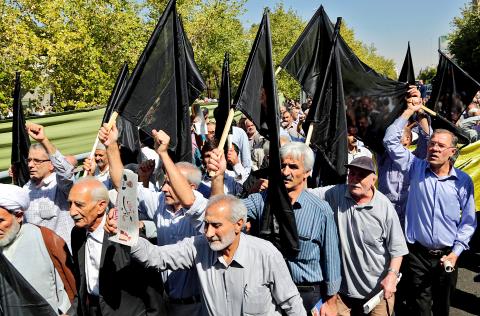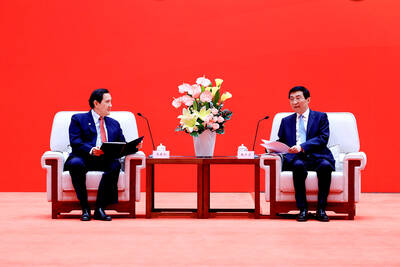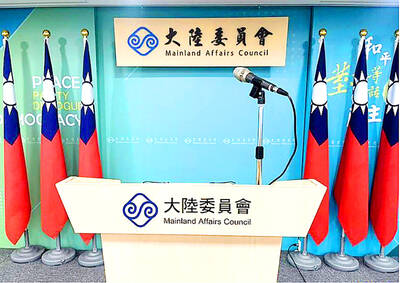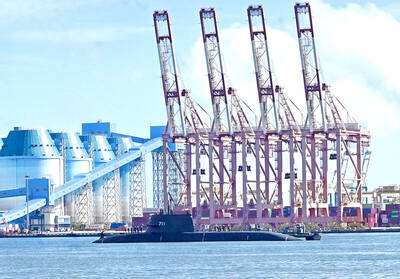Saudi Arabia, under growing pressure to account for a stampede that killed more than 700 people at Thursday’s hajjj, yesterday suggested that pilgrims failing to follow crowd control rules bore some blame for the worst such disaster in 25 years.
The kingdom’s regional rival, Iran, expressed outrage at the deaths of 131 of its nationals at the world’s largest annual gathering of people, and politicians in Tehran suggested Riyadh was incapable of managing the event.
“Death to the Saudi dynasty,” hundreds of demonstrators chanted at a protest in Tehran..

Photo: EPA
Saudi Minister of Health Khalid al-Falih said an investigation would be conducted rapidly and a final toll of dead and wounded calculated. At least 863 pilgrims were injured.
“The investigations into the incident of the stampede that took place today [Thursday] in Mina, which was perhaps because some pilgrims moved without following instructions by the relevant authorities, will be fast and will be announced as has happened in other incidents,” Falih said in a statement.
Falih’s comments were likely to be seen by the kingdom’s critics as an attempt to deflect responsibility for the incident: Safety during hajjj is politically sensitive for the kingdom’s Al Saud Dynasty, since the ruling family presents itself internationally as the guardian of orthodox Islam and custodian of its holiest places in Mecca and Medina.
With photographs of piles of the dead circulating on social media and pilgrims frantically searching for missing compatriots, the effort to uncover the facts and assign blame was likely to grow more acute and possibly more political.
The disaster appeared to put pilgrims on edge.
“It is simply scary to hear how people crushed one another,” said Hakim, from Morocco. “More frightening is that we do not know how it happened.”
A pilgrim who asked to be identified only as Abu Abdallah said security forces appeared on high alert after the deaths.
“What happened is a tragedy and many people ... are terrified, but in the end we can only pursue our hajj duties,” he said.
Saudi King Salman ordered a review of hajj plans after the disaster, in which two big groups of pilgrims collided at a crossroads in Mina, a few kilometers east of Mecca, on their way to performing the “stoning of the devil” ritual at Jamarat.
Iranian President Hassan Rouhani, in New York to attend the UN General Assembly, echoed Supreme Leader Ayatollah Ali Khamenei in blaming Riyadh for the incident.
“I ask the Saudi Arabian government to take responsibility for this catastrophe and fulfil its legal and Islamic duties in this regard,” Rouhani said in a statement published on the state news agency IRNA.
Iranian state television said the demonstrators in Tehran were showing their anger at “Saudi incapability and incompetence to run the hajj.”
“The world will not accept excuses like the weather was hot or the pilgrims were disorganized,” Tehran Friday prayer leader Mohammed Emami-Kashani was quoted as saying by Fars news agency.
Iranian Deputy Foreign Minister Hossein Amir Abdollahian also called “Riyadh’s negligence inexcusable” and announced a committee has been established to look into the incident.
Iranians pilgrims who survived the deadly incident described Saudi’s response as “too little, too late,” Iran’s state run Press TV said. They said the rescuers arrived at the scene two hours after the incident and started collecting dead bodies first instead of helping the injured.
Saudi Arabian Ministry of the Interior spokesman Major General Mansour Turki was quoted in Saudi media yesterday as saying the security forces had immediately responded and begun to rescue those who fell in the crush.

CHIP WAR: The new restrictions are expected to cut off China’s access to Taiwan’s technologies, materials and equipment essential to building AI semiconductors Taiwan has blacklisted Huawei Technologies Co (華為) and Semiconductor Manufacturing International Corp (SMIC, 中芯), dealing another major blow to the two companies spearheading China’s efforts to develop cutting-edge artificial intelligence (AI) chip technologies. The Ministry of Economic Affairs’ International Trade Administration has included Huawei, SMIC and several of their subsidiaries in an update of its so-called strategic high-tech commodities entity list, the latest version on its Web site showed on Saturday. It did not publicly announce the change. Other entities on the list include organizations such as the Taliban and al-Qaeda, as well as companies in China, Iran and elsewhere. Local companies need

CRITICISM: It is generally accepted that the Straits Forum is a CCP ‘united front’ platform, and anyone attending should maintain Taiwan’s dignity, the council said The Mainland Affairs Council (MAC) yesterday said it deeply regrets that former president Ma Ying-jeou (馬英九) echoed the Chinese Communist Party’s (CCP) “one China” principle and “united front” tactics by telling the Straits Forum that Taiwanese yearn for both sides of the Taiwan Strait to move toward “peace” and “integration.” The 17th annual Straits Forum yesterday opened in Xiamen, China, and while the Chinese Nationalist Party’s (KMT) local government heads were absent for the first time in 17 years, Ma attended the forum as “former KMT chairperson” and met with Chinese People’s Political Consultative Conference Chairman Wang Huning (王滬寧). Wang

CROSS-STRAIT: The MAC said it barred the Chinese officials from attending an event, because they failed to provide guarantees that Taiwan would be treated with respect The Mainland Affairs Council (MAC) on Friday night defended its decision to bar Chinese officials and tourism representatives from attending a tourism event in Taipei next month, citing the unsafe conditions for Taiwanese in China. The Taipei International Summer Travel Expo, organized by the Taiwan Tourism Exchange Association, is to run from July 18 to 21. China’s Taiwan Affairs Office spokeswoman Zhu Fenglian (朱鳳蓮) on Friday said that representatives from China’s travel industry were excluded from the expo. The Democratic Progressive Party government is obstructing cross-strait tourism exchange in a vain attempt to ignore the mainstream support for peaceful development

DEFENSE: The US would assist Taiwan in developing a new command and control system, and it would be based on the US-made Link-22, a senior official said The Ministry of National Defense is to propose a special budget to replace the military’s currently fielded command and control system, bolster defensive resilience and acquire more attack drones, a senior defense official said yesterday. The budget would be presented to the legislature in August, the source said on condition of anonymity. Taiwan’s decade-old Syun An (迅安, “Swift Security”) command and control system is a derivative of Lockheed Martin’s Link-16 developed under Washington’s auspices, they said. The Syun An system is difficult to operate, increasingly obsolete and has unresolved problems related to integrating disparate tactical data across the three branches of the military,